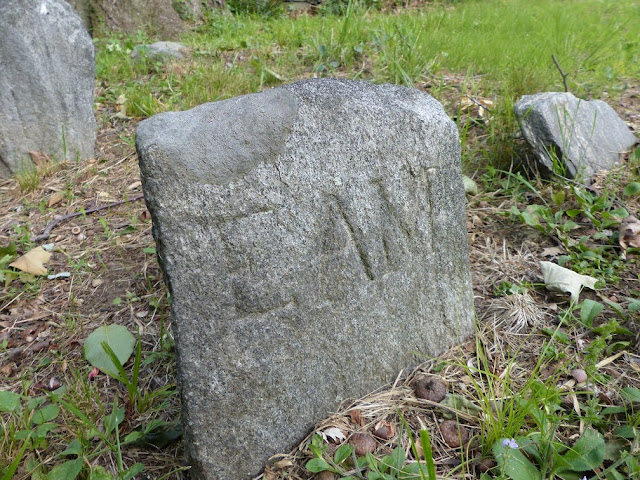Back home for a few weeks before my summer fieldwork begins, I decided to check out the truly impressive work that the historical society has done in making the woods surrounding the old Spencer Optical site into a fully fledged historical hiking trail. I was blown away by their accomplishments. The area that is now the trail was filled with trash and debris. Now it is completely clear, allowing people access to one of the loveliest spots (in my opinion) in the town.
You'd hardly know that 120 years ago this idyllic patch of forest was the site of the foremost manufacturer of eyeglasses in the world. Or maybe you would - if you looked hard enough.
I set out onto the trail determined to find some lenses. As you may recall from my previous posts on Spencer Optical, children have been finding lenses in these woods for decades, and we even
found one in our excavation of the St. George's/St. Mark's Church. However, I had never found any lenses at Spencer Optical myself, until now.
The trail begins on the side of the river opposite the factory site, then crosses the river and passes straight through it. For reference, here is a plan of the Spencer Optical site in 1885, featured in a Sanborn Fire Insurance Map. As you can see, the site consisted of two buildings: the main factory building, which was two stories with a tower and was made of brick, and the storage building, which was smaller and made of wood.

You can see both of these buildings in the photographs taken during the planning of the New York City watershed project in 1896. At this point, the factory had been abandoned for several years. The Spencer brothers had struggled to find a buyer for the property, which was essentially worthless after the draining of Kirby Pond
cut off its power source. Then, in 1896, the site - along with a large portion of the town - was acquired to construct the New York City watershed. Many buildings in the downtown area were torn down; it's possible that the factory buildings were torn down at this time, too, but I haven't been able to confirm it. After the 1890s, the area surrounding the factory buildings reverted to wilderness.

Walking through the trail, it is difficult to imagine that it was ever a thriving industrial center. The area is packed with trees and the ground is covered by a thick carpet of leaves and brush. However, looking closely, some clues stand out. To begin with, there is the
huge dam that we explored in fall of 2014. When intact, the dam closed off what was known as Geer's Pond. Now the water flows through it freely.
There are little chunks of brick and other debris washed down the river, which you can see on the first half of the trail, but the real discoveries begin when you have crossed the river and come to the side where the factory stood. It's difficult to capture in photographs, but there is a huge mound that is almost certainly the brick factory building pictured above. You can't tell what the mound is made of, because it is covered with leaves and brush, and there are even trees growing out of it, but if you dug down into it, I guarantee you would find the collapsed form of the building.


Surrounding the mound, you can find masses of bricks, chunks of mortar and cement, and random pieces of rebar - as well as the lenses, pictured above. When I first saw the lenses, I thought they were the broken pieces of a bottle. In fact, most of what I found in this area were not the lenses themselves, but the waste from the glass "blanks" into which the lenses were punched. They were on top of a small mound, beside a much larger mound, which I am guessing was used as a trash heap by the factory. The larger mound is covered with leaves, while the smaller mound looks like it was washed down from the larger one by rain and/or erosion, which is why the lenses were visible at the surface.
My guess is that if you excavated the larger mound - or perhaps just a section in profile - you would find a
lot more glass and other debris from the period when the factory was in use. To give you an idea of its scale, the factory produced about a half million pairs of eyeglasses per year, from 1874 to 1888.

 Canongate Kirkyard, located on the Royal Mile, is the final resting place of Adam Smith and Robert Fergusson, as well as many other less famous people. Above is the gravestone erected to Agnes Mouat, spouse to Robert Rutherfurd (the 18th- and 19th-century Scots were apparently fans of the gender-neutral designation "spouse"). There's a skull, a toppled hourglass, and what is presumably Agnes's spirit rising to heaven in the form of a winged head.
Canongate Kirkyard, located on the Royal Mile, is the final resting place of Adam Smith and Robert Fergusson, as well as many other less famous people. Above is the gravestone erected to Agnes Mouat, spouse to Robert Rutherfurd (the 18th- and 19th-century Scots were apparently fans of the gender-neutral designation "spouse"). There's a skull, a toppled hourglass, and what is presumably Agnes's spirit rising to heaven in the form of a winged head.












































